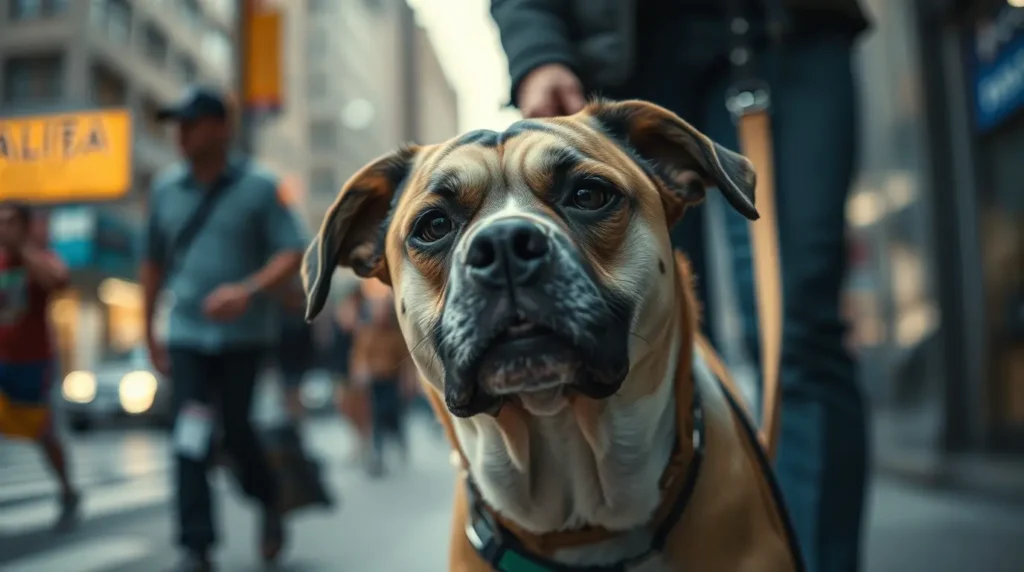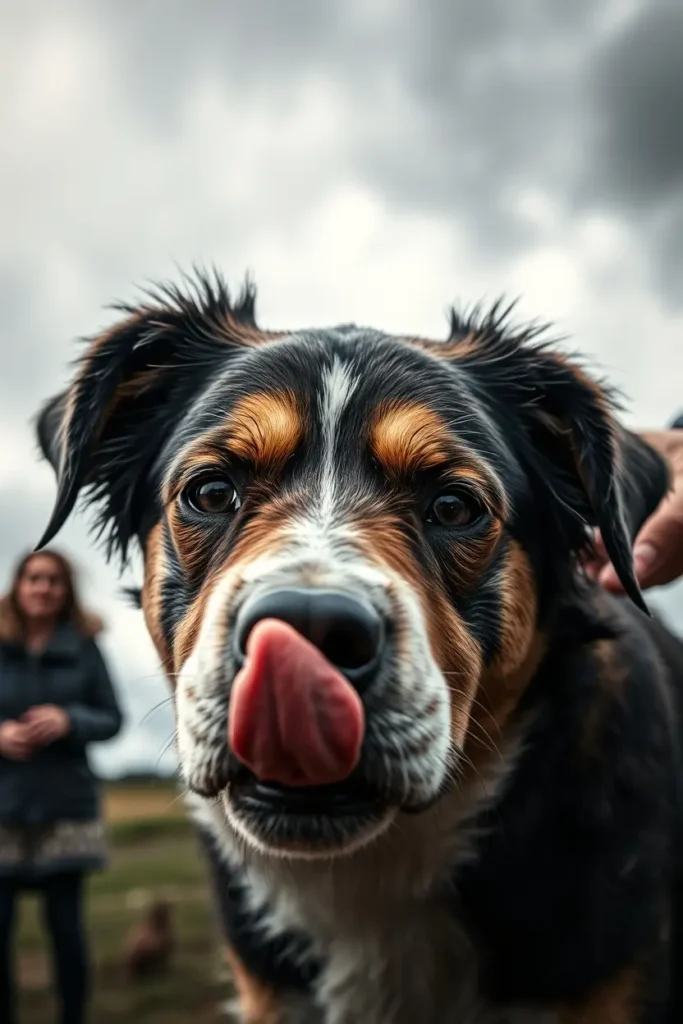Dog Training Stress: Dogs Make Facial Expressions
At Whizpet, we understand that dogs are highly expressive animals, and their faces reveal a great deal about their emotions. Through extensive research and analysis, we have explored how dog training stress impacts dogs’ facial expressions, helping dog owners and trainers gain deeper insights into their pets’ emotional states. By recognizing these subtle changes, you can improve your training techniques and strengthen the bond with your furry companion.
Our study on dog training stress and how dogs make facial expressions involved observing various breeds in different training scenarios, analyzing their stress responses, and consulting with canine behavior experts. The findings highlight that stress can cause dogs to display distinct facial expressions, such as widened eyes, furrowed brows, or lip licking. Understanding these cues allows pet owners to adjust training approaches, ensuring a positive learning experience.
If you can identify stress-related dog facial expressions, you can modify your methods to create a comfortable and rewarding training environment. This knowledge empowers you to communicate better with your dog, making training sessions more effective and stress-free for both you and your pet.
Understanding Dog Facial Expressions
Why Do Dogs Make Facial Expressions?
Dogs use facial expressions as part of their body language to communicate with humans and other animals. These expressions often indicate stress, happiness, excitement, or fear. Dog training stress affects dog facial expressions in ways that can reveal discomfort, helping trainers adjust methods to create a more positive experience. Whether your dog is excited, anxious, or relaxed, their facial cues provide essential information about their emotional state.
The Science Behind Canine Facial Expressions
Research has shown that dogs have at least 16 different facial expressions they use to communicate emotions. By understanding these expressions, owners can better interpret their dogs’ feelings and respond accordingly. Some common stress-related dog facial expressions include:
- Raised eyebrows (puppy dog eyes): Indicates confusion, anticipation, or mild stress.
- Lip licking: A sign of nervousness, discomfort, or submission.
- Whale eye (showing the whites of their eyes): Suggests fear, anxiety, or unease.
- Scrunched face: Often seen when a dog is uncertain, reacting to a new situation, or under pressure.
- Yawning: Can indicate stress or discomfort, especially if it occurs repeatedly in non-sleepy situations.
- Tensed jaw or clenched mouth: Often a sign of unease or heightened alertness.
- Droopy or pinned-back ears: Reflects nervousness, fear, or submission.
Observing these dog facial expressions during training or daily interactions can help you gauge how your dog is feeling. If your dog exhibits multiple signs of stress, consider adjusting your approach, offering positive reinforcement, and creating a more comfortable environment.

Recognizing Stress in Dogs During Training
1. Dog Stress Face: What It Looks Like
A stressed dog exhibits noticeable facial tension. Dog stress lines, which are furrowed brows or tightened lips, can appear when a dog is feeling overwhelmed.
2. Dog Facial Expressions Meaning: Decoding Their Emotions
Understanding what different facial expressions mean can help you improve training sessions:
- Relaxed Face: Mouth slightly open, relaxed eyes – the dog is calm and comfortable.
- Tensed Face: Wrinkled forehead, ears pulled back – the dog is stressed or fearful.
- Raised Lip or Snarl: A warning sign of discomfort or aggression.
- Drooping Eyes and Ears: A sign of exhaustion or sadness.
How Training Stress Affects Dog Facial Expressions
1. Dog Training Stress and Facial Expressions Meaning
When training becomes too intense, dogs may show stress through exaggerated facial expressions. Trainers must recognize these cues to avoid overloading the dog.
- Averting Gaze: Indicates that the dog is feeling pressured.
- Frequent Blinking: Can be a sign of stress or uncertainty.
- Tightened Jaw: Often a sign of discomfort.
2. Dog Training Stress and Funny vs. Serious Facial Expressions
Sometimes, dogs make expressions that seem humorous, like wide eyes or exaggerated yawns. However, these should not be dismissed as just “funny faces”—they might indicate discomfort. Learning to distinguish between playful and stressed expressions is crucial.
Tips for Reducing Training Stress in Dogs
1. Recognize Stress Signals Early
By observing dog facial expressions chart, owners and trainers can identify when a dog is feeling stressed and adjust their approach accordingly.
2. Use Positive Reinforcement
Reward-based training ensures that your dog associates learning with positive experiences rather than stress.
3. Keep Training Sessions Short
Overlong training can cause mental fatigue and stress. Limit sessions to 10-15 minutes to maintain focus and engagement.
4. Provide Breaks and Playtime
Frequent breaks allow dogs to process training and relax.
5. Adjust the Environment
Minimize distractions and choose a quiet, comfortable setting to train in.
How to Read Dog Facial Expressions: A Guide
Dog Facial Expressions Chart
| Expression | Meaning |
| Relaxed, open mouth | Content, happy |
| Whale eye | Fear, anxiety |
| Raised brows | Uncertainty, curiosity |
| Lip licking | Nervousness |
| Scrunched face | Confusion, stress |

Why Does My Dog Scrunch His Face When He Sees Me?
Dogs are incredibly expressive creatures, and their faces often reveal a lot about their emotions. If you’ve noticed your dog scrunching their face when they see you, it could mean a variety of things. Dog facial expressions can change based on emotions like excitement, confusion, anticipation, or even mild stress. Understanding why your dog makes this expression can help you respond appropriately and strengthen your bond with your furry friend.
Excitement and Anticipation
One of the most common reasons a dog scrunches its face when seeing its owner is pure excitement. Dogs love their humans, and their dog facial expressions often reflect their joy. If your dog’s ears are relaxed, their tail is wagging, and they appear playful, the scrunched face could be their way of showing enthusiasm. Some dogs even combine this expression with playful barking or zooming around.
Additionally, if your dog associates you with positive experiences like treats, walks, or belly rubs, they may scrunch their face in anticipation. This is especially true if they’ve learned that certain interactions (like you reaching for their leash) lead to something fun.
Confusion and Focus
Dogs also scrunch their faces when they are trying to understand something. If you say a new command or change your tone, your dog may furrow their brows, wrinkle their nose, or tilt their head slightly. This is their way of processing the situation and figuring out what you want from them.
During training, dogs often display these dog facial expressions when they are engaged but unsure. If you notice your dog scrunching their face while you give a command, it might mean they are concentrating and trying to decode your instructions.
Mild Stress or Uncertainty
Sometimes, a scrunched face can be a subtle sign of stress. If your dog looks tense, pulls their ears back slightly, or combines the scrunched face with lip licking or yawning, it could indicate mild anxiety. This is especially common in situations where a dog is unsure about what will happen next, such as during an unfamiliar training session.
Observing your dog’s body language is crucial in these moments. If their facial tension is accompanied by stiff posture, avoidance, or a tucked tail, they might be feeling uncomfortable. Adjusting your training methods to use positive reinforcement and short, rewarding sessions can help reduce stress-related dog facial expressions.
How to Respond to a Scrunched Face
- If your dog is excited, acknowledge their happiness with a warm greeting and engage in a fun activity.
- If they seem confused, simplify your commands or offer clear cues to help them understand.
- If stress is a factor, pause training and ensure your dog feels safe and comfortable before continuing.
By paying attention to your dog’s dog facial expressions, you can better understand their emotions and improve communication. Whether it’s excitement, curiosity, or mild stress, their facial cues provide valuable insight into their feelings and needs.
Frequently Asked Questions (FAQs)
1. How do I know if my dog is stressed during training?
Look for signs like whale eyes, lip licking, excessive yawning, or a scrunched face. These dog facial expressions indicate stress and discomfort.
2. Can stress affect my dog’s training progress?
Yes, stress can make learning difficult. If a dog is too anxious, they may struggle to focus and respond to commands.
3. What should I do if my dog shows stress during training?
Pause the session, give your dog a break, and use positive reinforcement to encourage a relaxed state before resuming.
4. Why do dogs show their teeth when they are stressed?
Baring teeth can be a sign of discomfort or a warning signal. It’s essential to recognize context to determine if it’s aggression or stress.
5. How can I make training a positive experience for my dog?
Keep sessions short, use rewards, recognize stress signals, and always create a safe and comfortable environment.
Conclusion
Recognizing how dog training stress affects dog facial expressions is essential for improving communication with your pet. By understanding dog facial expressions meaning, trainers can adjust techniques to reduce stress and ensure a positive experience. Training should be a rewarding process, and being mindful of canine emotions will strengthen the bond between you and your dog.
Call to Action
Do you want to improve your dog’s training experience? Start by observing their dog facial expressions and making adjustments accordingly. Share your experiences with us and let’s help our furry friends train in a stress-free environment!
Related blog: For more detailed information about pet care


Pingback: How to Use an E Collar or Remote Collar for Pain-Free Dog Training